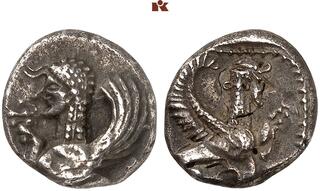| Fritz Rudolf Künker GmbH & Co. KG > Auction 402 | Auction date: 14 March 2024 |
| Lot number: 42 Price realized: 2,600 EUR (Approx. 2,831 USD) Note: Prices do not include buyer's fees. | Show similar lots on CoinArchives Find similar lots in upcoming auctions on |
| Lot description: LYCIA. Prä- und protodynastische Prägungen. Unbestimmter Dynast AR-Tetrobol, um 480/460 v. Chr., unbestimmte Münzstätte; 3,12 g. Sphinx sitzt l. mit erhobener Pranke//In Incusum: Sphinx sitzt r. mit erhobener Pranke. Müseler III, 24 (dies Exemplar). Von allergrößter Seltenheit. Herrliche Patina, gutes sehr schön Exemplar der Auktion The New York Sale XVII, New York 2008, Nr. 92. Es handelt sich möglicherweise um eine Prägung des Dynasten Amartite. Die Sphinx ist ein Monster, d.h. die Zusammenfügung von nicht zusammengehörenden Teilen verschiedener Körper. Sie hat einen geflügelten Löwenkörper und den Kopf eines Menschen, Widders oder Greifvogels. Ihr griechischer Name, der soviel wie Würger bedeutet, lässt erkennen, dass man sie für gefährlich hielt. Sie galt aber auch als weise und konnte den Menschen Rätsel aufgeben. Man verstand sie als die Begleiterin von Göttern, die sie und deren Heiligtümer schützte. Sie galt auch als Grabschützerin, was sie für die Lykier mit ihren aufwendigen Nekropolen besonders interessant machte; vgl. Richter 1961, 6: "... the function of a sphinx on the early gravestones was an eminently appropriate one – not hostile, not predatory, but one of a friendly guardian". Die Griechen übernahmen sie aus Ägypten und dem alten Orient. Besonders treffend ist ihr Wesen von Boussac 1982, 442 zusammengefasst: "Notre groupe semblerait pourtant entretenir d'étroites parentés avec les images composites que nous ont laissées aux époques hellénistique et romaine certaines divinités d'Asie Mineure, elles aussi accostées d'animaux et entourées de figures diverses. On pourrait notamment évoquer les deux sphinx, posés sur un piédestal, qui encadrent l'Artémis de Pergé, sur des monnaies d'époque impériale ou les trois monstres ailés qui entourent Jupiter de Beroea. On pense surtout aux figures ailées qui entourent à hauteur de la tête certaines images cultuelles: tantôt deux Nikés ou Erotes soutiennent les extrémités d'un voile ou d'un baldaquin qui passe au-dessus de la tête de l'idole, tantôt ils la couronnent. C'est le cas notamment pour Artémis Leukophryéné ou Artémis de Pergé." [JN] This could be an issue of the dynast Amartite. The sphinx is a monster, i.e. a combination of parts of different bodies that do not belong together. It has a winged lion's body and the head of a human, ram or bird of prey. Its Greek name, which means strangler, indicates that it was considered dangerous. However, it was also regarded as wise and could pose riddles to people. The sphinx was considered the companion of gods and protected their sanctuaries. It was also regarded as a guardian of graves, which is why the sphinx was of particular interest to Lycians with their elaborate burial monuments, cf. Richter 1961, 6: "... the function of a sphinx on the early gravestones was an eminently appropriate one – not hostile, not predatory, but one of a friendly guardian". The Greeks adopted the sphinx from Egypt and the Ancient Orient. Their nature is particularly aptly summarized by Boussac 1982, 442 (transl. by J. Nollé): "However, our group would seem to be closely related to composite images that certain deities of Asia Minor have left us in Hellenistic and Roman times. These deities are embellished with animals and surrounded by various figures. One might mention the two sphinxes, posed on a pedestal, encircling the Artemis of Pergé, on coins from the Imperial period, or the three monsters that surround Jupiter of Beroea. One thinks in particular of the winged creatures that surround certain cult images at the top of the face: sometimes two Nikes or Erotes support the extremities of a veil or a canopy that hovers above the idol's head; sometimes they crown it. This is particularly true of Artemis Leukophryene and Artemis of Pergé". [JN] Estimate: 1000 EUR |  |



